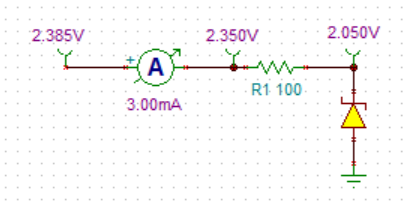Other Parts Discussed in Thread: REF35,
Hi Team,
We are using this 3V Shunt voltage reference IC (LM4040BIM3X-3.0/NOPB) in our design.
Our input voltage is 3.3V and desired output is 3V 3mA maximum. Using a series resistor of 100ohm.
We have not connected any load at output side of this circuit.
As per design the current flowing through the resistor should be V/R = (3.3 - 3)/100ohm = 3mA, but we were getting 1.5mA current through series resistor.
How this is possible? as per datasheet the minimum operating current is 65uA.



